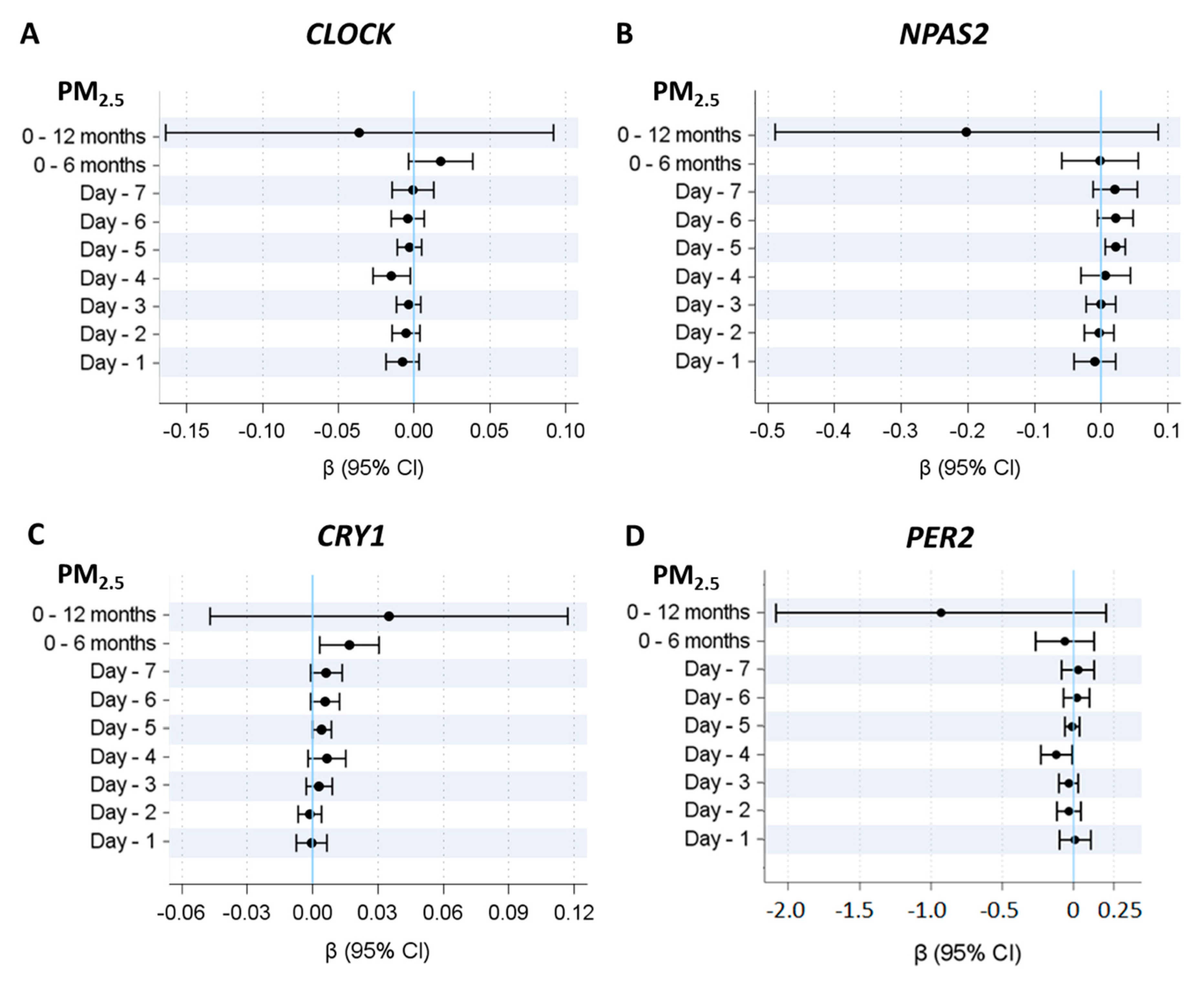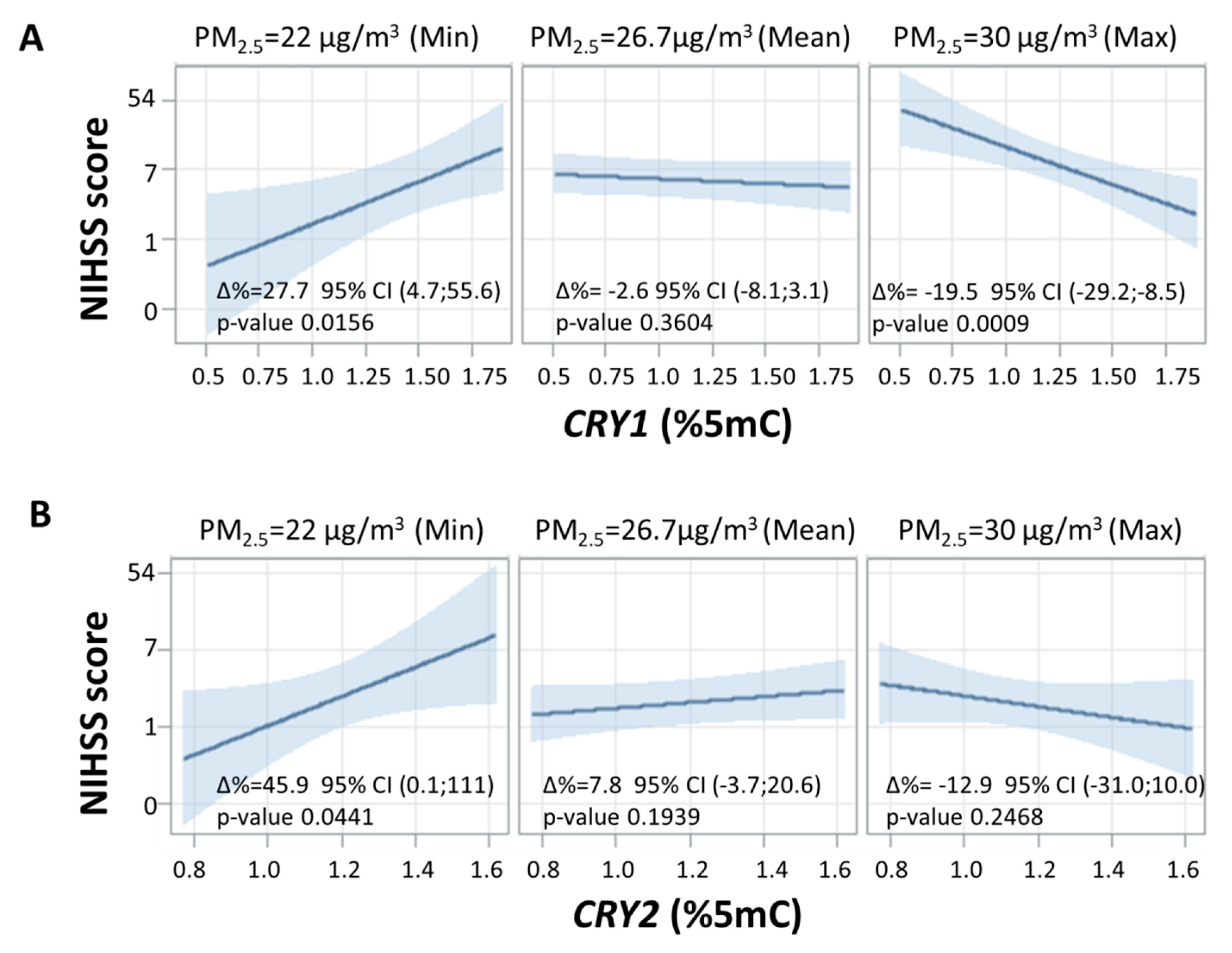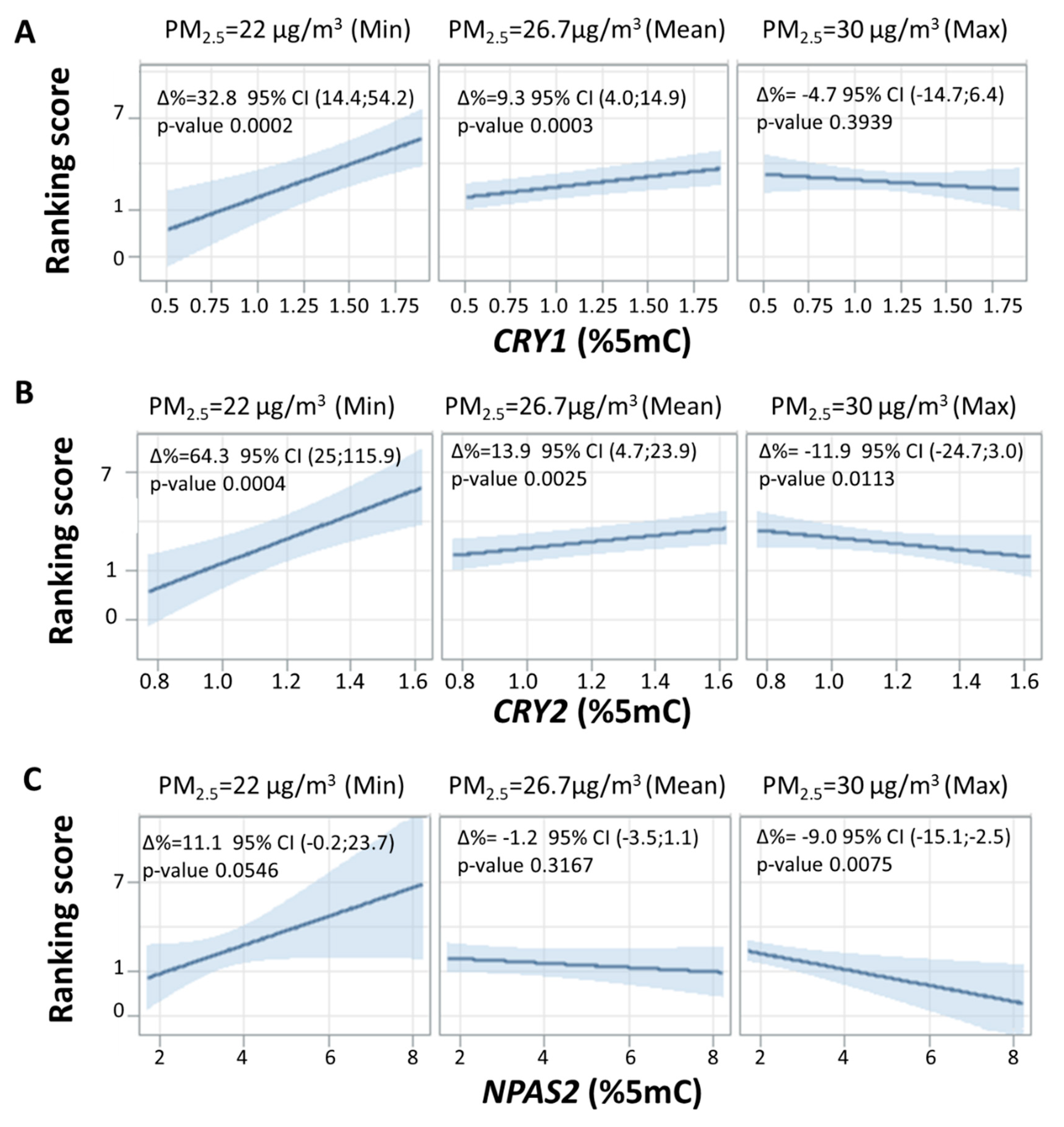Particulate Air Pollution, Clock Gene Methylation, and Stroke: Effects on Stroke Severity and Disability
Abstract
1. Introduction
2. Results
2.1. Study Population, DNA Methylation Levels, and Exposure Levels
2.2. Association between PM2.5 Exposure and Clock Gene Methylation
2.3. Association between PM2.5 Exposure and NIH Stroke Scale (NIHSS) or Modified Rankin Scale Score for Neurological Disability
2.4. Association between Clock Gene Methylation and NIH Stroke Scale (NIHSS) Score
2.5. Association between Clock Gene Methylation and Modified Rankin Scale for Neurological Disability
3. Discussion
4. Materials and Methods
4.1. Study Population
4.2. Exposure Assessment
4.3. Sample Collection, DNA Extraction, and Bisulfite Treatment
4.4. DNA Methylation
4.5. Statistical Analysis
Supplementary Materials
Author Contributions
Funding
Acknowledgments
Conflicts of Interest
References
- Rijo-Ferreira, F.; Takahashi, J.S. Genomics of circadian rhythms in health and disease. Genome Med. 2019, 11, 82. [Google Scholar] [CrossRef] [PubMed]
- Patke, A.; Young, M.W.; Axelrod, S. Molecular mechanisms and physiological importance of circadian rhythms. Nat. Rev. Mol. Cell Biol. 2019, 25, 1–8. [Google Scholar] [CrossRef]
- Robinson, I.; Reddy, A.B. Molecular mechanisms of the circadian clockwork in mammals. FEBS Lett. 2014, 588, 2477–2483. [Google Scholar] [CrossRef]
- Zhang, R.; Lahens, N.F.; Ballance, H.I.; Hughes, M.E.; Hogenesch, J.B. A circadian gene expression atlas in mammals: Implications for biology and medicine. Proc. Natl. Acad. Sci. USA 2014, 111, 16219–16224. [Google Scholar] [CrossRef] [PubMed]
- Gale, J.E.; Cox, H.I.; Qian, J.; Block, G.D.; Colwell, C.S.; Matveyenko, A.V. Disruption of circadian rhythms accelerates development of diabetes through pancreatic beta-cell loss and dysfunction. J. Biol. Rhythm. 2011, 26, 423–433. [Google Scholar] [CrossRef]
- Arble, D.M.; Bass, J.; Laposky, A.D.; Vitaterna, M.H.; Turek, F.W. Circadian timing of food intake contributes to weight gain. Obesity (Silver Spring) 2009, 17, 2100–2102. [Google Scholar] [CrossRef] [PubMed]
- Khan, M.S.; Aouad, R. The Effects of Insomnia and Sleep Loss on Cardiovascular Disease. Sleep Med. Clin. 2017, 12, 167–177. [Google Scholar] [CrossRef] [PubMed]
- Benedict, C.; Blennow, K.; Zetterberg, H.; Cedernaes, J. Effects of acute sleep loss on diurnal plasma dynamics of CNS health biomarkers in young men. Neurology 2020. [Google Scholar] [CrossRef]
- Takeda, N.; Maemura, K. The role of clock genes and circadian rhythm in the development of cardiovascular diseases. Cell. Mol. life Sci. CMLS 2015, 72, 3225–3234. [Google Scholar] [CrossRef]
- Rana, S.; Prabhu, S.D.; Young, M.E. Chronobiological Influence Over Cardiovascular Function: The Good, the Bad, and the Ugly. Circ. Res. 2020, 126, 258–279. [Google Scholar] [CrossRef]
- Takeda, N.; Maemura, K. Circadian clock and the onset of cardiovascular events. Hypertens. Res. Off. J. Jpn. Soc. Hypertens. 2016, 39, 383–390. [Google Scholar] [CrossRef] [PubMed]
- Bollinger, T.; Schibler, U. Circadian rhythms—from genes to physiology and disease. Swiss Med Wkly. 2014, 144, w13984. [Google Scholar] [CrossRef] [PubMed]
- Albrecht, U. Timing to perfection: The biology of central and peripheral circadian clocks. Neuron 2012, 74, 246–260. [Google Scholar] [CrossRef] [PubMed]
- Hernandez-Rosas, F.; Lopez-Rosas, C.A.; Saavedra-Velez, M.V. Disruption of the Molecular Circadian Clock and Cancer: An Epigenetic Link. Biochem. Genet. 2019. [Google Scholar] [CrossRef]
- Baccarelli, A.; Bollati, V. Epigenetics and environmental chemicals. Curr. Opin. Pediatrics 2009, 21, 243–251. [Google Scholar] [CrossRef]
- Bollati, V.; Baccarelli, A. Environmental epigenetics. Heredity 2010, 105, 105–112. [Google Scholar] [CrossRef]
- Fiordelisi, A.; Piscitelli, P.; Trimarco, B.; Coscioni, E.; Iaccarino, G.; Sorriento, D. The mechanisms of air pollution and particulate matter in cardiovascular diseases. Heart Fail. Rev. 2017, 22, 337–347. [Google Scholar] [CrossRef]
- Chen, R.; Gao, Q.; Sun, J.; Yang, H.; Li, Y.; Kang, F.; Wu, W. Short-term effects of particulate matter exposure on emergency room visits for cardiovascular disease in Lanzhou, China: A time series analysis. Environ. Sci. Pollut. Res. Int. 2020. [Google Scholar] [CrossRef]
- Yuan, S.; Wang, J.; Jiang, Q.; He, Z.; Huang, Y.; Li, Z.; Cai, L.; Cao, S. Long-term exposure to PM2.5 and stroke: A systematic review and meta-analysis of cohort studies. Environ. Res. 2019, 177, 108587. [Google Scholar] [CrossRef]
- Ljungman, P.L.S.; Andersson, N.; Stockfelt, L.; Andersson, E.M.; Nilsson Sommar, J.; Eneroth, K.; Gidhagen, L.; Johansson, C.; Lager, A.; Leander, K.; et al. Long-Term Exposure to Particulate Air Pollution, Black Carbon, and Their Source Components in Relation to Ischemic Heart Disease and Stroke. Environ. Health Perspect. 2019, 127, 107012. [Google Scholar] [CrossRef]
- Nawrot, T.S.; Saenen, N.D.; Schenk, J.; Janssen, B.G.; Motta, V.; Tarantini, L.; Cox, B.; Lefebvre, W.; Vanpoucke, C.; Maggioni, C.; et al. Placental circadian pathway methylation and in utero exposure to fine particle air pollution. Environ. Int. 2018, 114, 231–241. [Google Scholar] [CrossRef] [PubMed]
- Gorelick, P.B. The global burden of stroke: Persistent and disabling. Lancet. Neurol. 2019, 18, 417–418. [Google Scholar] [CrossRef]
- Hong, Y.C.; Lee, J.T.; Kim, H.; Ha, E.H.; Schwartz, J.; Christiani, D.C. Effects of air pollutants on acute stroke mortality. Environ. Health Perspect. 2002, 110, 187–191. [Google Scholar] [CrossRef]
- Crnko, S.; Du Pre, B.C.; Sluijter, J.P.G.; Van Laake, L.W. Circadian rhythms and the molecular clock in cardiovascular biology and disease. Nature reviews. Cardiology 2019, 16, 437–447. [Google Scholar] [CrossRef]
- Stubblefield, J.J.; Lechleiter, J.D. Time to Target Stroke: Examining the Circadian System in Stroke. Yale J. Biol. Med. 2019, 92, 349–357. [Google Scholar] [PubMed]
- Shen, M.J.; Zipes, D.P. Role of the autonomic nervous system in modulating cardiac arrhythmias. Circ. Res. 2014, 114, 1004–1021. [Google Scholar] [CrossRef] [PubMed]
- Scheer, F.A.; Shea, S.A. Human circadian system causes a morning peak in prothrombotic plasminogen activator inhibitor-1 (PAI-1) independent of the sleep/wake cycle. Blood 2014, 123, 590–593. [Google Scholar] [CrossRef] [PubMed]
- Schuliga, M. The inflammatory actions of coagulant and fibrinolytic proteases in disease. Mediat. Inflamm. 2015, 2015, 437695. [Google Scholar] [CrossRef]
- Rider, C.F.; Carlsten, C. Air pollution and DNA methylation: Effects of exposure in humans. Clin. Epigenetics 2019, 11, 131. [Google Scholar] [CrossRef] [PubMed]
- Ferrari, L.; Carugno, M.; Bollati, V. Particulate matter exposure shapes DNA methylation through the lifespan. Clin. Epigenetics 2019, 11, 129. [Google Scholar] [CrossRef] [PubMed]
- Sun, B.; Shi, Y.; Yang, X.; Zhao, T.; Duan, J.; Sun, Z. DNA methylation: A critical epigenetic mechanism underlying the detrimental effects of airborne particulate matter. Ecotoxicol. Environ. Saf. 2018, 161, 173–183. [Google Scholar] [CrossRef] [PubMed]
- Schlegel, D.; Kolb, S.J.; Luciano, J.M.; Tovar, J.M.; Cucchiara, B.L.; Liebeskind, D.S.; Kasner, S.E. Utility of the NIH Stroke Scale as a predictor of hospital disposition. Stroke 2003, 34, 134–137. [Google Scholar] [CrossRef] [PubMed]
- Broderick, J.P.; Adeoye, O.; Elm, J. Evolution of the Modified Rankin Scale and Its Use in Future Stroke Trials. Stroke 2017, 48, 2007–2012. [Google Scholar] [CrossRef]
- Cattani, G.; Di Menno di Bucchianico, A.; Dina, D.; Inglessis, M.; Notaro, C.; Settimo, G.; Viviano, G.; Marconi, A. Evaluation of the temporal variation of air quality in Rome, Italy, from 1999 to 2008. Ann. Dell’istituto Super. Sanita 2010, 46, 242–253. [Google Scholar] [CrossRef]
- Tarantini, L.; Bonzini, M.; Tripodi, A.; Angelici, L.; Nordio, F.; Cantone, L.; Apostoli, P.; Bertazzi, P.A.; Baccarelli, A.A. Blood hypomethylation of inflammatory genes mediates the effects of metal-rich airborne pollutants on blood coagulation. Occup. Environ. Med. 2013, 70, 418–425. [Google Scholar] [CrossRef] [PubMed]
- Bollati, V.; Baccarelli, A.; Hou, L.; Bonzini, M.; Fustinoni, S.; Cavallo, D.; Byun, H.M.; Jiang, J.; Marinelli, B.; Pesatori, A.C.; et al. Changes in DNA methylation patterns in subjects exposed to low-dose benzene. Cancer Res. 2007, 67, 876–880. [Google Scholar] [CrossRef]



| Characteristics | Value |
|---|---|
| Age (years) | 74.6 ± 13.9 |
| Sex: | |
| Male | 31 (56.4%) |
| Female | 24 (43.6%) |
| BMI (kg/m2) | 24.8 ± 3.8 |
| Blood pressure (mmHg): | |
| Systolic | 162 ± 26 |
| Diastolic | 89 ± 16 |
| Glucose (mg/dL) | 120.2 ± 30.9 |
| Hypertension: | |
| Yes | 37 (67.3%) |
| Diabetes: | |
| Yes | 8 (14.5%) |
| Atrial fibrillation: | |
| Yes | 17 (30.9%) |
| Heart failure: | |
| Yes | 6 (10.9%) |
| Previous stroke or TIA: | |
| Yes | 16 (29.1%) |
| Smoking status: | |
| Never smoked | 36 (65.5%) |
| Current smoker | 12 (21.8%) |
| n.a. | 7 (12.7%) |
| Hb (g/dL) | 13.8 ± 1.7 |
| Ht (%) | 40.1 ± 4.3 |
| Plt × 103 (N/μL) | 225 (193, 304) |
| AST (U/L) | 23.1 ± 8.8 |
| ALT (U/L) | 19.2 ± 9.1 |
| PT | 1.12 ± 0.37 |
| aPTT | 0.95 ± 0.12 |
| Albumin (g/dL) | 3.9 ± 0.4 |
| Creatinine (mg/dL) | 1.03 ± 0.34 |
| C-reactive protein (mg/dL) | 0.34 (0.15, 0.66) |
| Total cholesterol (mg/dL) | 183 ± 34.9 |
| Characteristics | Value |
|---|---|
| NIHSS score on admission: | 7.5 (5,14) |
| <14 | 36 (65.5%) |
| ≥14 | 14 (25.4%) |
| n.a. | 5 (9.1%) |
| Therapy: | |
| Yes | 31 (56.4%) |
| n.a. | 8 (14.5%) |
| TOAST: | |
| Atherombotic | 6 (10.9%) |
| Cardioembolic | 21 (38.2%) |
| Lacunar | 2 (3.7%) |
| Indeterminate | 16 (29.1%) |
| n.a. | 10 (18.1%) |
| Hemisphere of stroke: | |
| Right | 22 (40.0%) |
| Left | 23 (41.8%) |
| Bilateral | 3 (5.5%) |
| n.a. | 7 (12.7%) |
| Circle segments: | |
| Anterior | 42 (76.4%) |
| Posterior | 6 (10.9%) |
| n.a. | 7 (12.7%) |
| Modified Rankin score at 3 months: | 2.95 ±2.5 |
| 0–2 | 20 (36.4%) |
| 3–5 | 10 (18.2%) |
| 6 | 13 (23.6%) |
| n.a. | 12 (21.8%) |
| Scale | Clock Gene Methylation | ∆% | 95% CI | p-Value | |
|---|---|---|---|---|---|
| NIHSS score | ARNTL | −2.22 | −4.13 | −0.27 | 0.0256 |
| CLOCK | −0.13 | −2.21 | 1.99 | 0.9038 | |
| NPAS2 | −0.88 | −2.72 | 0.98 | 0.3510 | |
| CRY1 | −2.98 | −8.65 | 3.05 | 0.3251 | |
| CRY2 | 1.93 | −9.38 | 14.66 | 0.7498 | |
| PER1 | 0.87 | −2.00 | 3.83 | 0.5550 | |
| PER2 | −0.03 | −0.32 | 0.27 | 0.8622 | |
| PER3 | −0.25 | −0.59 | 0.09 | 0.1543 | |
| Modified Rankin score | ARNTL | 0.35 | −4.37 | 5.31 | 0.8857 |
| CLOCK | 1.77 | −1.91 | 5.59 | 0.3493 | |
| NPAS2 | −1.92 | −4.50 | 0.73 | 0.1537 | |
| CRY1 | 8.39 | 1.92 | 15.28 | 0.0103 | |
| CRY2 | 7.51 | −2.65 | 18.73 | 0.1527 | |
| PER1 | −3.12 | −6.01 | −0.14 | 0.0406 | |
| PER2 | −0.24 | −0.50 | 0.02 | 0.0756 | |
| PER3 | −0.25 | −0.56 | 0.07 | 0.1253 | |
© 2020 by the authors. Licensee MDPI, Basel, Switzerland. This article is an open access article distributed under the terms and conditions of the Creative Commons Attribution (CC BY) license (http://creativecommons.org/licenses/by/4.0/).
Share and Cite
Cantone, L.; Tobaldini, E.; Favero, C.; Albetti, B.; Sacco, R.M.; Torgano, G.; Ferrari, L.; Montano, N.; Bollati, V. Particulate Air Pollution, Clock Gene Methylation, and Stroke: Effects on Stroke Severity and Disability. Int. J. Mol. Sci. 2020, 21, 3090. https://doi.org/10.3390/ijms21093090
Cantone L, Tobaldini E, Favero C, Albetti B, Sacco RM, Torgano G, Ferrari L, Montano N, Bollati V. Particulate Air Pollution, Clock Gene Methylation, and Stroke: Effects on Stroke Severity and Disability. International Journal of Molecular Sciences. 2020; 21(9):3090. https://doi.org/10.3390/ijms21093090
Chicago/Turabian StyleCantone, Laura, Eleonora Tobaldini, Chiara Favero, Benedetta Albetti, Roberto M. Sacco, Giuseppe Torgano, Luca Ferrari, Nicola Montano, and Valentina Bollati. 2020. "Particulate Air Pollution, Clock Gene Methylation, and Stroke: Effects on Stroke Severity and Disability" International Journal of Molecular Sciences 21, no. 9: 3090. https://doi.org/10.3390/ijms21093090
APA StyleCantone, L., Tobaldini, E., Favero, C., Albetti, B., Sacco, R. M., Torgano, G., Ferrari, L., Montano, N., & Bollati, V. (2020). Particulate Air Pollution, Clock Gene Methylation, and Stroke: Effects on Stroke Severity and Disability. International Journal of Molecular Sciences, 21(9), 3090. https://doi.org/10.3390/ijms21093090







